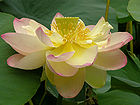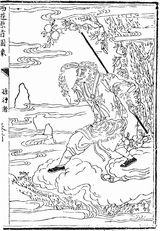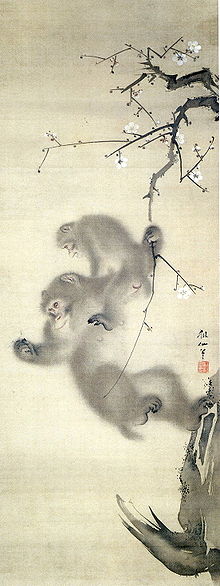- Mind monkey
-
Lands India • China • Japan
Vietnam • Korea
Singapore • Taiwan
Tibet • Bhutan • Nepal
Mongolia • United StatesDoctrine Bodhisattva • Śīla
Samādhi • Prajñā
Śunyatā • TrikāyaMahāyāna Sūtras Prajñāpāramitā Sūtras
Lotus Sūtra
Nirvāṇa Sūtra
Saṃdhinirmocana Sūtra
Avataṃsaka Sūtra
Śūraṅgama SūtraMahāyāna Schools Mādhyamaka
Yogācāra
Esoteric Buddhism
Pure Land • Zen
Tiantai • Nichiren
Mind monkey or Monkey mind, from Chinese xinyuan and Sino-Japanese shin'en 心猿 [lit. "heart-/mind-monkey"], is a Buddhist term meaning "unsettled; restless; capricious; whimsical; fanciful; inconstant; confused; indecisive; uncontrollable". In addition to Buddhist writings, including Chan or Zen, Consciousness-only, Pure Land, and Shingon, this "mind-monkey" psychological metaphor was adopted in Daoism, Neo-Confucianism, poetry, drama, and literature. "Mind-monkey" occurs in two reversible four-character idioms with yima or iba 意馬 [lit. "thought-/will-horse"], most frequently used in Chinese xinyuanyima 心猿意馬 and Japanese ibashin'en 意馬心猿. The "Monkey King" Sun Wukong in the Journey to the West personifies the mind-monkey. Note that much of the following summarizes Carr (1993).Contents
Linguistic and cultural background
"Mind-monkey" 心猿 is an exemplary animal metaphor. Some figures of speech are cross-linguistically common, verging upon linguistic universals; many languages use "monkey" or "ape" words to mean "mimic", for instance, Italian scimmiottare "to mock; to mimic" < scimmia "monkey; ape", Japanese sarumane 猿真似 [lit. "monkey imitation"] "copycat; superficial imitation", and English monkey see, monkey do or to ape). Other animal metaphors have culture-specific meanings; compare English chickenhearted "cowardly; timid'; easily frightened" and Chinese jixin 雞心 [lit. "chicken heart"] "heart-shaped; cordate".
The four morphological elements of Chinese xinyuanyima or Japanese shin'en'iba are xin or shin 心 "heart; mind", yi or i 意 "thought", yuan or en 猿 "monkey", and ma or ba 馬 "horse"'.
The 心 "heart; mind" and 意 "idea; will"
The psychological components of the "mind-monkey will-horse" metaphor are Chinese xin or Sino-Japanese shin or kokoro 心 "heart; mind; feelings, affections; center" and yi or i 意 'thought, idea; opinion, sentiment; will, wish; meaning'. This Chinese character 心 was graphically simplified from an original pictogram of a heart, and 意 "thought; think" is an ideogram combining 心 under yin 音 "sound; tone; voice" denoting "sound in the mind; thought; idea".
In Chinese Buddhism and Japanese Buddhism, xin/shin 心 "heart; mind" generally translates Sanskrit citta "the mind; state of mind; consciousness" and yi/i 意 translates Sanskrit manas "the mental organ; deliberation". Some Buddhist authors have used 心 and 意 interchangeably for "mind; cognition; thought". Compare these Digital Dictionary of Buddhism glosses
- 心 "Spirit, motive, sense. The mind as the seat of intelligence, mentality, idea. (Skt. citta) … Thought, intellect, feeling; (Skt. mānasa)"
- 意 "Thought, intellect; (Skt. manas; Tib. yid); the mind; (Skt. citta; Tib. sems)".
For example, take the Buddhist word Chinese xin-yi-shi or Japanese shin-i-shiki 心意識 [lit. "mind, thought, and cognition"] that compounds three near-synonyms. Abhidharma theory uses this word as a general term for "mind; mentality", but Yogacara theory of Eight Consciousnesses distinguishes xin/shin 心 "store consciousness", yi/i 意 "manas consciousness", and shi/shiki 識 "six object-contingent consciousnesses".
Xinyuanyima 心猿意馬 [lit. "mind-monkey idea-horse"] "distracted; indecisive; restless" is comparable with some other Chinese collocations.
- xinmanyizu 心滿意足 ["heart-full mind-complete"] "perfectly content; fully satisfied"
- xinhuiyilan 心灰意懶 ["heart-ashes mind-sluggish"] "disheartened; discouraged; hopeless" (or xinhuiyileng 心灰意冷 with leng "cold; frosty")
- xinhuangyiluan 心慌意亂 ["heart-flustered mind-disordered"] "alarmed and hysterical; perturbed"
- xinfanyiluan 心煩意亂 ["heart-vexed mind-disordered"] "terribly upset; confused and worried"
The 猿 "monkey" and 馬 "horse"
The animal components of the "mind-monkey will-horse" metaphor are Chinese yuan or Japanese en 猿 "gibbon; monkey; ape" and ma or ba 馬 "horse".
Chinese yuan 猿 (yuan 猨 or nao 猱) originally meant the "Agile Gibbon, Black-handed Gibbon, Hylobates agilis" but now generally means "ape; monkey" (e.g., yuanren 猿人 ["ape-man"] "Homo erectus; anthropoid apes'"). Robert van Gulik (1967:33) concludes that until about the fourteenth century, yuan designated the gibbon, but due to extensive deforestation, its habitat shrank to remote southern mountains; from then on, "the majority of Chinese writers knowing about the gibbon only by hearsay, they began to confuse him with the macaque or other Cynopithecoids." Other common Chinese "monkey" names include feifei 狒狒 "Hamadryas baboon, Papio hamadryas", hou 猴 "monkey; ape", and mihou 獼猴 (muhou 母猴) or husun 猢猻 "rhesus macaque, rhesus monkey, Macaca mulatta", Victor H. Mair (1990:36) reconstructs Old Sinitic *mug-gug, which "probably ultimately derives from the same African word as English 'macaque'" and is reminiscent of Sanskrit "maraṭāsana ('monkey posture')" (see Hanumanasana). These "monkey; ape" characters combine the 犭 "dog radical" with different phonetic elements, such as the yuan 袁 phonetic in yuan 猿.
In Chinese mythology, yuan "gibbons" were supposedly long-lived because they could yinqi 引氣 ["pull qi"] "absorb life-force", which is a daoyin 導引 ["guiding and pulling"] "Daoist gymnastic technique". Chinese classic texts mentioned "monkey leaping" and "monkey bowing" yoga (Miura 1989:354). One of the 2nd-century BCE Mawangdui Silk Texts depicts 28 Daoist gymnastic exercises, many of which are named after animals, including number 22 muhou "macaque". In the present day, houquan 猴拳 ["monkey fist/boxing"] "Monkey Kung Fu" is a Chinese martial arts style and xinyuanyima "mind-monkey will-horse" is a Daoist breath meditation technique.
When one breathes in and out, one's concentration causes the generative force to rise and fall (in the microcosmic orbit) thus slowly turning the wheel of the law. Count from one to ten and then from ten to one hundred breaths with the heart (mind) following the counting to prevent it from wandering outside. When the heart and breathing are in unison, this is called locking up the monkey heart and tying up the running horse of intellect. (Luk 1990:48)
The Japanese kanji 猿 is pronounced as Sino-Japanese en < yuan or native saru "monkey", especially the indigenous "Japanese Macaque, Macaca fuscata". In Japanese Shinto tradition, the monkey deity Sarutahiko was a divine messenger. Emiko Ohnuki-Tierney (1987:41) contrasts how, "in earlier periods the dominant meaning of the monkey was that of mediator between deities and humans. Later in history, its meaning as a scapegoat became increasingly dominant."
Chinese ma 馬 "horse", which was the linguistic source for Sino-Japanese ba or ma 馬 "horse", originally referred to Przewalski's Horse and later the Mongolian horse, Ferghana horse, etc. Horses were considered divine animals in both China (see Creel 1968) and Japan. For the Chinese, Edward H. Schafer says,
He was invested with sanctity by ancient tradition, endowed with prodigious qualities, and visibly stamped with the marks of his divine origin. A revered myth proclaimed him a relative of the dragon, akin to the mysterious powers of water. Indeed, all wonderful horses, such as the steed of the pious Hsüan-tsang which, in later legend [see the Xiyouji below], carried the sacred scriptures from India, were avatars of dragons, and in antiquity the tallest horses owned by the Chinese were called simply "dragons." (1963:59)
For the Japanese, the ancient Shinto practice of offering shinme 神馬 "sacred (esp. white) horses" to shrines has evolved into the modern donation of symbolic Shinto ema 絵馬 [lit. "picture horse"] "votive tablets"'.
Besides the "mind-monkey idea-horse" metaphor, monkeys and horses have further associations. In Chinese astrology, wu 午 "Horse" and shen 申 "Monkey" are the 7th and 9th of the 12 zodiacal animals. In Chinese animal mythology, monkeys supposedly bring good health to horses. The Bencao Gangmu (tr. Read 1931, no. 400) records the "custom of keeping a female monkey in the horse's stable to ward off sickness (the menstrual discharge of the monkey is said to give immunity to the horse against infectious diseases)".
Early literary history of "mind-monkeys"
This section summarizes Chinese and Japanese developments of xinyuan or shin'en 心猿 "mind-monkey" and yima or iba 意馬 "idea-horse" collocations and their synonyms. The earliest known textual usages are presented chronologically.
Chinese "mind monkey" collocations
Chinese authors coined "mind monkey" expressions from the Later Qin Dynasty (384-417 CE) through the Song Dynasty (960-1279 CE). In modern usage, some terms are considered Classical Chinese, but others like xinyuanyima "mind-monkey will-horse" are Modern Standard Chinese. Unless otherwise noted, translations are by Carr (1993:154-159).
Development of Chinese Mind-monkey Terms Date (CE) Text Simplified characters Traditional characters Pinyin Wade-Giles Literal meaning ca. 406 Weimojiesuoshuojing 心如猿猴 心如猨猴 xīn rú yuánhóu hsin ju yuan-hou "mind like a monkey" ca. 540 Mengyu chanhui shi 爱马 … 心猿 愛馬 … 心猿 àimǎ … xīnyuán ai-ma … hsin-yüan "love-horse … mind-monkey" 657 Daci'ensi sanzang fashizhuan 情猿 … 意马 情猿 … 意馬 qíngyuán … yìmǎ ch'ing-yüan … i-ma '"feelings-monkey … will-horse" ca. 840 Zengti Du yinju 心猿 … 意马 心猿 … 意馬 xīnyuán … yìmǎ hsin-yüan … i-ma "mind-monkey … will-horse" 947 Bianwen weimojiejing 心猿意马 心猿意馬 xīnyuányìmǎ hsin-yüan-i-ma "mind-monkey will-horse" ca. 1180 Shuixuanshi 意马心猿 意馬心猿 yìmǎxīnyuán i-ma-hsin-yüan "will-horse mind-monkey" The ca. 406 Weimojie suoshuo jing 維摩詰所說經 was Kumarajiva's groundbreaking CE Chinese translation of the Vimalakirti Sutra. It introduced "mind-monkey" in the simile xin ru yuanhou 心如猨猴 "heart/mind like a monkey/ape" (with yuan 猿's variant Chinese character 猨). "Since the mind of one difficult to convert is like an ape, govern his mind by using certain methods and it can then be broken in" (tr. Dudbridge 1970:168). Carr (1993:169) suggests the subsequent line about xiang ma 象馬 "elephants and horses" having unruly natures could have affected the later yima "idea-horse" term.
The Mengyu chanhui shi 蒙預懺悔詩 "Poem Repenting Foolish Pleasure" is attributed to Emperor Jianwen of Liang (503-550 CE), who was a renowned author. This poem has the oldest known usage of xinyuan "mind-monkey", but with (the possibly miscopied) aima 愛馬 "love-horse" instead of yima 意馬 "idea-horse". "The [三循/修] three disciplines/cultivations expel the [愛馬] love-horse, and the [六意/念] six recollections/ideas still the [心猿] mind-monkey." This Buddhistic poem has numerous graphic variants, including these sanxun 三循 "three disciplines" for sanxiu 三修 "three cultivations" (meditation on impermanence, awareness, and selflessness) and liuyi 六意 "six ideas" for liunian 六念 "six recollections" (mindfulness about Buddha, dharma, sangha, precepts, almsgiving, and heaven). Based on these contextual graphic inconsistencies, Carr (1993:156) suggests the possibility that a scribe transposed Jianwen's original yima 意馬 "idea-horse" as aima 愛馬 "love-horse".
The Daci'ensi sanzang fashizhuan 大慈恩寺三藏法師傳 "Biography of the Tripitaka Dharma Master of the Temple of Great Compassionate Blessings" is a biography of Xuanzang (see the Xiyouji below) written by his disciple Kuiji (or Ci'en, the namesake temple in Luoyang, see Emperor Gaozong of Tang). This record of the Consciousness-Only (Yogacara) Buddhism, has a memorial dated 657 CE that parallels yima "idea-/will-horse" with qingyuan 情猿 "emotion-/feeling-monkey": "Now if you wish to entrust your thoughts to the Chan sect, you must make your mind as pure as still water, control your emotion-monkey's indolence and fidgeting, and restrain your idea-horse's haste and galloping."
The Tang Dynasty poet Xu Hun 許渾 (fl. 832-844) wrote the first known parallel between "mind-monkey" and "idea-horse." His Zengti Du yinju 贈題杜隱居 "Poem Written for Sir Du the Recluse" says: "Nature exhausts the mind-monkey's hiding, spirit disperses the idea-horse's moving/stopping. Guests who come ought to know this: both self and world are unfeeling."
The common xinyuanyima "mind-monkey will-horse" phrase dates back to a bianwen 變文 "Vernacular Chinese transformation text" narrative version of the Weimojie suoshuo jing (above) that was discovered in the Mogao Caves. This jiangjingwen 講經文 "sutra lecture text" dated 947 CE says: "Within the indeterminable and unfathomable depths, the mind-monkey and idea-horse cease their craziness."
The 1075 CE Wuzhen pian, which is a Daoist classic on Neidan-style internal alchemy, used xinyuan "mind-monkey" without "horse".
Thoroughly understanding the mind-monkey, the machinations in the heart, by three thousand achievements one becomes a peer of heaven. There naturally is a crucible to cook the dragon and tiger; Why is it necessary to support a household and be attached to spouse and children? (tr. Cleary 1987:118)
Cleary (1987:198) glosses xinyuan as "the unruly mind, jumping from one object to another."
The Song Dynasty poet Zhu Yi 朱翌 (1098–1186 CE) reversed the Tang lyrical xinyuanyima expression into yimaxinyuan "will-horse mind-monkey". His Shuixuanshi 睡軒詩 "Sleeping Porch Poem" says: "Haste is useless with the idea-horse and mind-monkey, so take off your baggage someplace deep within dreamland."
The ca. 1200 Nan Tang shu 南唐書 "History of the Southern Tang" used the simile yi ru ma xin ru nao 意如馬心如猱 "ideas like a horse and mind like a gibbon/monkey". Congshan 從善 (939-987), seventh son of the figurehead Emperor Yuanzong of Southern Tang, confesses: "Long ago in my youth, my ideas were like a horse and my mind was like a monkey. I was indolent with happiness and enjoyed lust, was pleased with rewards and forgot toil."
The ca. 1590 Xiyouji 西遊記 "Journey to the West" (or "Monkey") popularized "mind-monkey" more than any other text. This famous Chinese novel centers upon the pilgrimage of Xuanzang to India, and frequently uses xinyuan and yima expressions (Dudbridge 1970:167, Chang 1983:200). Many are found in the couplet titles of chapters, for instance, 30 "The evil demon attacks the true Dharma; The Horse of the Will recalls the Monkey of the Mind". The preeminent translator Anthony C. Yu (1977:59) describes controlling the mind-monkey and will-horse as "a theme central to the entire narrative and which receives repeated and varied developments." Chapter 7 has this exemplary poem:
A monkey's transformed body weds the human mind. Mind is a monkey – this, the truth profound. The Great Sage [Buddha], Equal to Heaven, is no idle thought. For how could the post of [Bima "Assistant of Horses"] justly show his gifts? The Horse works with the Monkey – and this means both Mind and Will, Must firmly be harnessed and not ruled without. All things return to Nirvāna, taking this one course: In union with Tathāgata [Buddha] to live beneath twin trees. (tr. Yu 1977:168)
Many Xiyouji scholars allegorically interpret xinyuan "heart-/mind-monkey" as the protagonist monkey-man Sun Wukong and yima "idea-/will-horse" as the dragon prince White Horse that enters the story in chapter 15. There are long-standing scholarly disagreements over whether Sun Wukong evolved from Hanuman, the monkey hero in the (3rd cent. BCE) Ramayana. It is "imagistically proper" for Sun to be a monkey, says Mair (1989:662), because "Zen thought symbolizes the restless and unbridled mind of man as an "ape/monkey-mind" 心猿."
Japanese "mind-monkey" collocations
Japanese
Buddhism
Schools Hosso • Kegon • Ritsu • Tendai • Shingon • Pure Land • Zen • Nichiren Founders Saichō • Kūkai • Hōnen • Shinran • Dōgen • Eisai • Ingen • Nichiren Sacred Texts Glossary of
Japanese Buddhism



